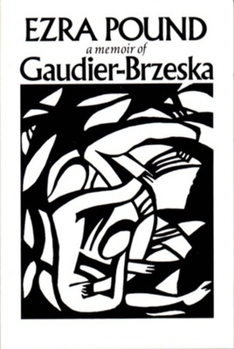Gaudier-Brzeska: A Memoir
Select Format
Select Condition 
Book Overview
Ezra Pound's book on the French sculptor Henri Gaudier-Brzeska was first published in 1916. An enlarged edition, including thirty pages of illustrations (sculpture and drawings) as well as Pound's later pieces on Gaudier, was brought out in 1970, and is now re-issued as an ND Paperbook. The memoir is valuable both for the history of modern art and for what it shows us of Pound himself, his ability to recognize genius in others and then to publicize it effectively. Would there today be a Salle Gaudier-Brzeska in the Mus e de L'Art Moderne in Paris if Pound had not championed him? Gaudier's talent was impressive and his Vorticist aesthetic important as theory, but he was killed in World War I at the age of twenty-three, leaving only a small body of work. Pound knew Gaudier in London, where the young artist had come with his companion, the Polish-born Sophie Brzeska. whose name he added to his own. They were living in poverty when Pound bought Gaudier the stone from which the famous "hieratic head" of the poet was made. Pound arranged exhibitions and for the publication of Gaudier's manifestoes in Blast and The Egoist. And he wrote and sent packages to him in the trenches, where Gaudier--a sculptor to the last--carved a madonna and child from the butt of a captured German rifle, just two days before he died.
Format:Paperback
Language:English
ISBN:0811205274
ISBN13:9780811205276
Release Date:January 1974
Publisher:New Directions Publishing Corporation
Length:176 Pages
Weight:0.40 lbs.
Dimensions:0.5" x 5.2" x 7.9"
Customer Reviews
1 rating
Searching and revealing
Published by Thriftbooks.com User , 20 years ago
Writen by one of the greatest writers of the 20th century, this is a documented example of an artist determined to go against the odds of poverty and obscurity to create his passion in art. Henri Gaudier, killed in WWI, who had created such a large body of work at an age when most people were still trying to figure out what to do in life, probably would have fallen from existance completly if it was not for the tireless promotions done by Ezra Pound. Pound's quest in bringing to light the few of worthy talent who would otherwise be lost in the sludge of mediocracy is an example of the "rather than looking at the master's finger, look at what the finger points at" belief by following in example rather than observing what is shown. Instead of fawning over the man brought to the attention of the artworld, you are persuaded to become aware of those who have yet to be recognized. With being more sensitive to that which defines the 'good' from the 'not-so-good,' we benefit by learning from those who are worthy to learn from.





